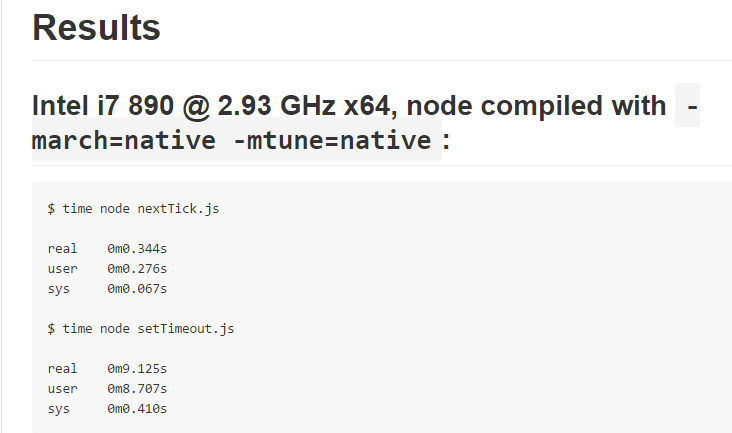
In general using child processes and running multiple node applications as separate processes together with a load balancer or shared data storage (like redis) is important for scaling your code. This should be neglible and if it matters you need to seriously consider what your trying to do, why you need such accuracy and what kind of real time alternative hardware is available to do the job instead.
#SETTIMEOUT NODEJS CODE#
This way even if some long blocking code is running in your main process your child process has already started itself and placed a setTimeout in a new process and a new thread and will thus run when you expect it to.įurther complication are at a hardware level where you have more threads running then processes and thus context switching will cause (very minor) delays from your expected timing. Use the child process module to spawn a new node.js program that does your logic and pass data to that process through some kind of a stream (maybe tcp). The only way to ensure code is executed is to place your setTimeout logic in a different process. This method is used to schedule the execution of code after a given period in milliseconds. In this section, we will look at the Node.js setTimeout() method. As discussed earlier, Node.js API provides utilities, which enable us to execute code at a later time based on our requirements. Remove the loop and you'll see it's 500 on the nose. By default, when a timer is scheduled using either setTimeout() or setInterval(), the Node.js event loop will continue running as long as the timer is active. Scheduling timers using setTimeout() method. Unless the interpreter optimises the loop away (which it doesn't on chrome), you'll get something in the thousands. fiddle with the number of iterations depending on how quick your machine is Consider this example: setTimeout(function (), 500) The reason for this is that there is no preemption of JavaScript by JavaScript. In Node, this is 1ms, but in browsers it can be as much as 50ms. Furthermore, passing 0, a non-number, or a negative number, will cause it to wait a minimum number of ms.

If process.nextTick () is called in a given phase, all the callbacks passed to process. The setTimeout function doesn’t block other code and the rest of the code is executed and after a specified time the code inside setTimeout function is executed.

On any given context process.nextTick () has higher priority over setImmediate (). The setTimeout () executes the function passed in the first argument after the time specified in the second argument.

Since the Timer object is a global object, we need not require() anything in our code when working with the setTimeOut() function. setTimeout () is processed in the Check handlers phase, while process.nextTick () is processed at the starting of the event loop and between each phase of the event loop. This module provides various methods that we can use to schedule functions to be called after some specified time. The semantics of setTimeout are roughly the same as in a web browser: the timeout arg is a minimum number of ms to wait before executing, not a guarantee. The setTimeOut() function is provided under the Timers module.


 0 kommentar(er)
0 kommentar(er)
